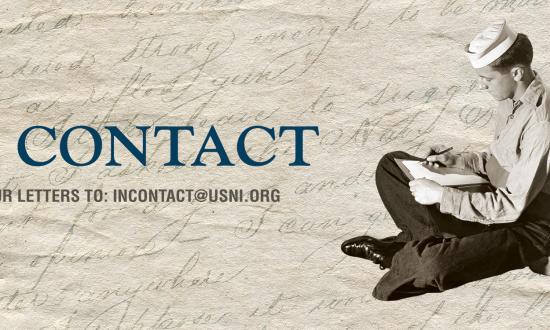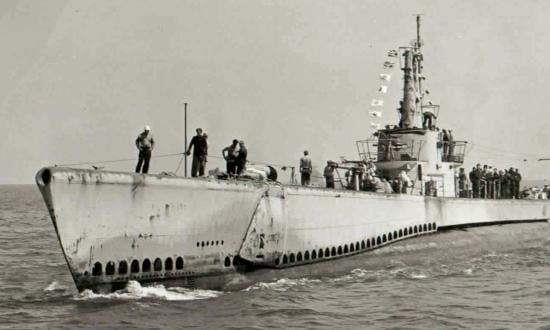John Paul Jones’ Greatest Victory, Revisited
Chuck Davis
John Paul Jones’ 1779 victory at the Battle of Flamborough Head is always a fascinating story, as Trevor Brigham’s article proves again. (See “Two Forgotten Accounts of the Battle of Flamborough Head,” February, pp. 14–21.) The newly rediscovered account by Midshipman David Jordan of HMS Serapis is especially detailed and graphic in its conveyance of the savagery.
At the risk of indulging in trivia and repetition, here are some anecdotes about the famous battle:
One account claims that, when Jones was asked if he had struck his colors, what he actually said was, “I may sink, but damned if I’ll strike!” as opposed to the iconic “I have not yet begun to fight!” It was very noisy at the time.
Captain Richard Pearson of the Serapis was knighted for saving most of his convoy (and the crews). Jones allegedly said, “If we fight again, I’ll make him an earl.”
The U.S. Naval Academy Museum has a stars-and-stripes flag handmade by some English ladies of Flamborough Head and sent to Jones. It is displayed in rotation in Jones’ crypt at the Academy.
‘He . . . Chose to Fight’
Theodore Kuhlmeier
In Nicholas Evan Sarantakes’ excellent article (see “Making Good Once More,” February, pp. 30–37), he mentions the participation, in the British Pacific Fleet, of Commonwealth nations including Canada. As Max Hastings notes in Retribution: The Battle for Japan (Knopf, 2008), after the war against Germany had ended, the Canadian government announced that only those Canadians who chose to continue serving in the war against Japan needed to do so. The vast majority of the crew of the light cruiser HMCS Uganda, mentioned in the article, voted to go home. With difficulty, they were persuaded to stay until replacements arrived. This makes the subsequent 9 August 1945 heroism of Canadian Lieutenant Robert Hampton Gray, described in the article, even more exemplary. He could have gone home but chose to fight.
The Bull’s Questionable Justifications
Barrett Tillman
Dr. Sarantakes’ description of the British Pacific Fleet’s operations raises a valid point about the questionable wisdom of Admiral William F. Halsey Jr.’s insistence on attacking Japan’s remaining capital ships in Kure and elsewhere in June and July 1945. The author quotes the justifications given in Halsey’s splashy, often self-serving memoir.
Here’s my assessment from Whirlwind: The Air War Against Japan, 1942–1945 (Simon & Schuster, 2010).
Taking Halsey’s contentions in order:
America’s national honor demanded total destruction of the Imperial Japanese Navy (IJN). How that argument arose is never explained, especially since the Allies already demanded Japan’s unconditional surrender.
Total destruction of remaining IJN capital ships was “necessary” to prevent them intercepting U.S. convoys to Russia. The notion is absurd on its face. The “doggo” fleet at Kure was hemmed in by mines, out of fuel, and more than 1,000 miles from the convoy routes, not to mention the dominant presence of U.S. submarines and aircraft.
Total destruction was “necessary” to prevent Tokyo using its remaining immobile fleet as a bargaining chip, as Germany had attempted in 1919. As per America’s national honor, the claim was moot at the time because the Allies required unconditional surrender.
Finally, Halsey was all too willing to comply with orders from Fleet Admirals Ernest King and Chester Nimitz, apparently eager to run up the Navy’s score against the near-future certainty of an independent U.S. Air Force. Halsey wrote, “If the other reasons had been invalid, that one alone would have been enough for me.”
The 200,000 tons of immobilized capital ships at Kure alone represented the biggest flak trap in naval history. Reportedly, Vice Admiral John McCain, commanding Halsey’s Third Fleet carriers, objected to the Kure strikes as unprofitable. But he obeyed orders, and by my count expended more than 80 young men in about 100 aircraft.
Many of the fliers tasked with executing the orders were disgusted with “the Bull.” A USS Shangri-La (CV-38) aviator wrote, “Halsey is going wild on publicity and we are all fed up to the teeth listening to all the crap he is putting out. . . . Halsey is a big disappointment to me as he is to most of us.”
One More Thing to Keep You Up at Night
C. Henry Depew
Andrew K. Blackley presents a very well thought-out and well-written article on a potential problem in the Pacific—the World War II “legacy bases” still scattered across the Central Pacific. (See “A Double-Edged Sword,” February, pp. 22–29.) It prompts one to think: Are there adequate security and/or law enforcement forces in place to protect/defend the island airfields from hostile or terrorist attacks? Are the armed forces of the United States prepared for a timely response to such
an attack?
Corrections: On page 46, left column, second line from the bottom, in the February issue, the year should read “1865.” On page 46, right column, third line from bottom, the year should read “1912.”





